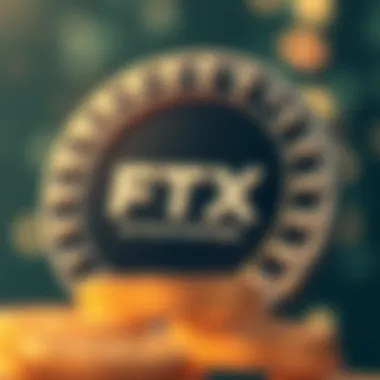Exploring FTX US Tokens: Insights and Implications


Intro
In recent years, the cryptocurrency realm has zoomed into the limelight, captivating the imaginations of investors, developers, and everyday enthusiasts alike. One component that has gained particular traction is the influx of tokens, such as those found on the FTX US platform. As the digital currency landscape continues to evolve, understanding the nuances of these tokens is essential for anyone looking to traverse this dynamic space.
In this article, we will unpack the FTX US tokens ecosystem. We will explore the diverse range of tokens available and their unique functionalities. Together, these aspects weave an intricate tapestry that shapes the larger cryptocurrency landscape.
Furthermore, we will delve into how these tokens fit into trading frameworks, the regulatory issues surrounding them, and how they influence user experience and overall market dynamics. There's plenty to dissect, and a comprehensive exploration of the future trajectory of FTX US tokens will also lead us to potential opportunities and challenges that lie ahead. As we journey through this informative piece, our goal is to unravel the complexities of FTX US tokens, ensuring clarity and enlightenment for all parties involved.
Preamble to FTX US Tokens
The rise of cryptocurrency has not only altered the financial landscape but has also made a significant impact on how digital assets are perceived and utilized. Within this shifting terrain, FTX US Tokens have emerged as a crucial element of the broader blockchain ecosystem. Understanding these tokens is essential for anyone looking to navigate the complexities of digital currencies in the US market. This section aims to shed light on what FTX US Tokens are, their advantages, and the vital role they play in today's rapidly evolving financial systems.
Defining FTX US Tokens
FTX US Tokens are specific digital assets that operate on the FTX US platform, which is tailored for the American trading sphere. These tokens come in various forms—including native tokens, stablecoins, and utility tokens—each serving distinct purposes within the cryptocurrency space.
For instance, native tokens, like FTT, are often used for trading fee discounts or staking purposes, allowing users to participate more economically in the FTX ecosystem. Stablecoins, such as USDC, are pegged to the US dollar, providing a stable medium of exchange in a volatile market. Utility tokens, on the other hand, empower users to access specific services or functionalities within the platform, enhancing user engagement.
Grasping these definitions helps investors and enthusiasts make informed decisions as they engage with the FTX US marketplace. By understanding the intricacies and significance of each token type, users can strategically position themselves to capitalize on market opportunities.
The Emergence of FTX in the Crypto Space
Founded in 2019, FTX has quickly risen to prominence in the crypto trading scene. What sets FTX apart isn't just its broad range of offerings but its commitment to innovate continuously, which has drawn a diverse user base from casual investors to institutional players.
FTX US was created as a response to the growing demand for a regulated and compliant platform in the US. Unlike other exchanges that might have skirted regulatory oversight, FTX US emphasizes adherence to the legal frameworks set forth by US laws and regulations. This focus enables users to trade with a sense of security that they might not get elsewhere.
By catering specifically to the US audience, FTX US has created an environment where traders can engage with various tokens while remaining compliant with domestic regulations. This has not only facilitated growth for the platform but also spurred further developments within the cryptocurrency sector as a whole. The exchange's ability to foster a secure trading environment reflects a growing understanding that as the industry evolves, regulatory compliance becomes non-negotiable for sustainability and trust.
Types of Tokens on FTX US
Understanding the different types of tokens on FTX US is crucial for anyone looking to navigate the intricacies of the cryptocurrency market. Each type of token offers distinct benefits and functionalities, tailored to specific needs within the ecosystem. By grasping these differences, users can make informed decisions, optimize their trading strategies, and harness the potential of these digital assets effectively.
Native Tokens
Native tokens act as the backbone of the FTX US platform. They represent the actual currency within the FTX ecosystem, granting users various benefits. One significant example is FTT, which serves as the native token on its platform. By holding FTT, users can access lower trading fees, participate in profit sharing, and engage in other exclusive features that enhance their trading experience.
Furthermore, native tokens often play a vital role in liquidity. When traders use them, it often results in tighter spreads and better price execution, which can lead to more favorable outcomes for investors. In addition, they can sometimes be staked for additional rewards, providing yet another avenue for generating returns.
Stablecoins
In the world of cryptocurrency, volatility is a common concern. This is where stablecoins come into play, offering a bridge between the crypto market and traditional finance. These tokens are pegged to stable assets, such as the U.S. dollar, to maintain their value over time. On FTX US, prominent stablecoins include USDC and Tether.
The primary draw of stablecoins lies in their ability to maintain solidity in an otherwise turbulent market. Traders often utilize these tokens as a safe haven during downturns, ensuring that they do not have to convert their assets back to fiat currencies, which could be more time-consuming and expensive. Additionally, stablecoins facilitate seamless transactions on the platform, enabling users to move quickly between various assets.
Utility Tokens
Utility tokens on platforms like FTX US enable holders to access specific services within the ecosystem. These tokens are not directly tied to any fiat currency and are designed for various purposes, such as governance or transaction facilitation. An example can be FTX’s utility tokens, which provide holders with unique privileges such as voting rights on platform upgrades or access to exclusive trading features.
The significance of utility tokens cannot be understated, especially for active traders and platform users. They contribute to the user engagement on the platform, while also fostering an environment of collaboration and community decision-making. Moreover, as FTX evolves and new utilities are introduced, demand for these tokens may increase, leading to potential appreciation in their market value.


This diverse range of tokens on FTX US ultimately showcases the platform's versatility and capacity to cater to different user needs. Each token type plays a pivotal role, whether it’s enhancing liquidity, providing stability, or facilitating operational features. By understanding these various tokens, users can better position themselves in the competitive world of cryptocurrency.
Understanding Token Functionality
In the rapidly evolving arena of digital currencies, understanding the functionality of tokens within platforms like FTX US is paramount. Tokens represent more than just a speculative asset; they are the bedrock of functionality in the cryptocurrency ecosystem. Grasping their roles can reveal insights into trading strategies, potential investment opportunities, and the overall health of the market.
Trading Mechanics of FTX US Tokens
The trading mechanics behind FTX US tokens play a crucial role in determining how traders interact with their chosen assets. When users buy or sell tokens, they participate in an intricate web of exchanges that rely on market orders and limit orders, among other tools. Market orders execute trades immediately at the current market price, whereas limit orders allow traders to specify the price at which they wish to buy or sell.
Understanding these mechanics is essential for maximizing trading efficiency. For instance, if a trader anticipates a price increase, placing a limit order at a lower price can be a strategic move to secure an advantageous position. Conversely, market orders can be beneficial in volatile situations where timing is everything.
Moreover, utilizing FTX US’s offering of margin trading can amplify potential profits. However, it's also critical to be aware of the risks involved, as leverage can also lead to amplified losses. The choice of trading strategy and mechanics utilized on FTX US should align with individual risk tolerance and market acumen.
Liquidity and Market Depth
Liquidity is the lifeblood of any trading platform. In relation to FTX US tokens, liquidity refers to how easily tokens can be bought or sold without causing significant price changes. Market depth itself measures the volume of buy and sell orders at various price points, providing insights into the supply and demand dynamics of a particular token.
A shallow market may lead to slippage, where traders end up executing orders at prices that are significantly different from their intended prices due to insufficient order matching. On the other hand, deep markets generally offer better execution prices and a more favorable trading experience.
Here are some key aspects to understand about liquidity and market depth:
- High liquidity can lead to lower transaction costs, as tighter spreads reduce the difference between buying and selling prices.
- Market makers often enhance liquidity by continuously placing buy and sell orders, stabilizing prices in the process.
In the context of FTX US tokens, monitoring liquidity and market depth can assist traders in making informed decisions and optimizing their trading strategies.
Smart Contract Integration
Smart contracts are a significant innovation soaring through the crypto universe. On platforms like FTX US, these self-executing contracts with predefined rules pave the way for automated transactions without the need for intermediaries. This functionality streamlines processes and enhances security.
For example, smart contracts can facilitate decentralized exchanges, where tokens are traded directly between users' wallets without reliance on a centralized authority. This model minimizes transaction fees and counters the risks associated with centralized exchanges, such as hacks or system failures.
Some pivotal elements of smart contract integration include:
- Automatic execution: Transactions are executed automatically once conditions coded in the contract are met, promoting efficiency.
- Transparency and security: The immutable nature of blockchain ensures that contract terms are visible and cannot be altered retrospectively, enhancing trust.
In summary, the understanding of token functionality on FTX US is not merely academic. It has real-world implications for trading strategies, risk management, and the ease of transaction processes. For anyone looking to delve deeper into the crypto landscape, these elements are a fundamental piece of the puzzle.
"The functionality of tokens is integral to navigating the cryptocurrency landscape effectively. Without a clear understanding, even experienced traders can find themselves in turbulent waters."
For those interested in expanding their knowledge on these topics, further reading can be found at Wikipedia - Smart Contracts or Investopedia - Liquidity.
Understanding this framework not only provides clarity but also equips traders, investors, and developers with the insight necessary to engage meaningfully in the world of FTX US tokens.
Regulatory Landscape for FTX US Tokens
The regulatory framework is pivotal in shaping the landscape for FTX US tokens. With the cryptocurrency environment evolving at a swift pace, understanding the intricacies of compliance and regulation is vital for users and stakeholders alike. The implications of these regulations extend far beyond mere legality; they affect trading practices, token integration, and market liquidity. Regulatory bodies aim to ensure transparency and protect investors from volatility and potential fraud inherent in the crypto space. As FTX US tokens gain traction, a clear grasp of the surrounding regulations offers a roadmap for navigating this fluctuating terrain effectively.
Compliance with US Financial Regulations


Compliance with US financial regulations is not just a box to check; it’s a foundational aspect of legitimacy in the cryptocurrency domain. The emphasis on adhering to laws set forth by institutions like the Securities and Exchange Commission (SEC) and the Commodity Futures Trading Commission (CFTC) influences how tokens are structured and traded. Regulatory measures involve scrutiny of how tokens are classified—be it as securities, commodities, or otherwise—affecting everything from issuance to trading practices.
By conforming to financial regulations, companies can earn much-needed trust from users and investors. A few points worth highlighting include:
- Investor Protection: Regulators seek to establish safeguards against fraud. Ensuring platforms operate within the law creates a safer environment for traders.
- Market Stability: Compliance can lead to reduced market volatility, as it encourages responsible trading and transparency.
- Clear Market Guidance: Regulations help delineate acceptable practices, providing clarity to operators on how to conduct business legitimately.
Impact of Regulatory Changes
Regulatory changes can significantly influence not just the operations of FTX US tokens, but the broader cryptocurrency ecosystem. As new rules emerge, the impact ripples through the community, affecting trading behaviors, token valuation, and investor sentiment.
Consider these potential effects:
- Market Adaptation: As regulations evolve, platforms may need to make substantial adjustments to their operational frameworks, requiring rapid updates and strategic pivots. This can strain resources but also yield new opportunities as regulations clarify what is permissible in the crypto sphere.
- User Confidence: Clear and structured regulatory guidelines can bolster user confidence. If individuals feel secure that their investments are safeguarded, participation may rise, subsequently enhancing liquidity and market activity.
- Innovation Incentives: On the flip side, overly stringent regulations can stifle innovation. Developers and startups might find it burdensome to navigate a product-building environment fraught with legal hurdles. Therefore, lawmakers must strike a balance to foster growth while ensuring necessary protections.
"The road ahead for cryptocurrency regulation is not without its bumps, but a well-structured approach could pave the way for a more vibrant market."
In summary, understanding the regulatory landscape for FTX US tokens is crucial for existing and potential participants. It shapes operational frameworks, impacts user interactions, and determines future market trajectories. As regulations continue to evolve, staying informed is essential for anyone engaged in this dynamic sector.
For further insights on crypto regulations, you can visit resources like SEC.gov and CFTC.gov.
User Experience on the FTX US Platform
User experience on the FTX US platform is a pivotal aspect of engaging with crypto investments. In the fast-paced world of cryptocurrency, a smooth and intuitive interface can be the difference between success and frustration. Handling crypto shouldn't feel like deciphering a cryptic puzzle; rather, it should be as straightforward and user-friendly as possible. As more traders and investors flock to digital currencies, FTX US has carved out a niche by focusing on how users interact with its platform. Excellent user experience is not merely a luxury; it’s a necessity for retention and satisfaction.
Account Setup and Wallet Management
Setting up an account on FTX US is akin to opening a new bank account, but with its own unique quirks. Users must verify their identities, a process that often includes submitting identification documents, such as a driver's license or a passport, ensuring compliance with regulatory demands. This can become tedious, but it's a crucial step. Once verification is complete, users are faced with wallet management.
On FTX US, the wallet interface is designed for simplicity. Users can view their token balances without any convoluted navigation. The platform supports both custodial and non-custodial wallets, providing flexibility depending on the user's preference. Each option presents clear benefits: custodial wallets offer ease of use, while non-custodial wallets grant more control over private keys. It's essential to understand the differences and to choose an approach that suits one's trading style. An effective user experience will encourage traders to participate actively without feeling overwhelmed.
Fee Structures and Trading Costs
Understanding fee structures is not just for the mathematically inclined. On FTX US, fees can significantly affect overall trading profitability, especially in high-frequency trading scenarios. The platform employs a tiered fee structure based on trading volume that rewards frequent traders. This encourages activity and can lower costs over time. However, new users often overlook these intricacies, leading to unexpected charges.
It’s important to consider the various fees that might come into play, including:
- Trading Fees: Usually a small percentage of the transaction amount, they can vary based on volume.
- Withdrawal Fees: Charged when transferring assets out of the platform, these can differ based on the specific token.
- Deposit Fees: While FTX US does not charge for deposits via crypto, users must remain aware of possible bank charges when funding their accounts.
A clear break down of costs is vital for an informed trading strategy. A transparent fee structure boosts user trust and encourages new investors to engage without fear of hidden costs.
Security Features and Protocols
With the growing threat landscape in the crypto sphere, security on the FTX US platform is paramount. The platform employs a multi-faceted security approach, reminiscent of the measures banks take to protect assets. Security protocols include:
- Two-Factor Authentication (2FA): An essential defense mechanism demanding a second form of identification beyond just a password.
- Cold Storage of Assets: A hefty chunk of user assets is kept offline to deter hacking attempts, showcasing the commitment to safety.
- Regular Security Audits: Frequent assessments of the platform's security infrastructure reassure users that vulnerabilities are actively managed.
"Security isn't just a checkbox; it's an ongoing commitment to protect users in the volatile landscape of cryptocurrencies."
Maintaining a solid security posture not only protects investors but also fosters confidence in the platform itself. When users feel secure, they're more likely to engage wholeheartedly with their crypto activities.


Market Dynamics and Trading Strategies
Understanding the dynamics that govern the market for FTX US tokens is essential for anyone actively engaged in this digital ecosystem. Market dynamics encompass the forces that influence the trading environment, including supply and demand, price volatility, and investor sentiment. A grasp of these elements allows participants to craft informed trading strategies that can maximize returns and mitigate risks. Moreover, understanding market dynamics can provide insights into how the broader landscape of cryptocurrency is evolving, particularly in relation to regulatory developments, technological advancements, and competitor behaviors.
Analyzing Market Trends
To navigate the FTX US token space, one must stay attuned to the latest market trends. Trends signify the general direction in which the market is moving—be it upward, downward, or sideways. Tools such as technical analysis—which often involves charting historical price movements—can equip traders with the ability to predict potential price patterns. One might observe:
- Price Action: Analyzing the historical price changes of a specific token can signal support and resistance levels.
- Market Sentiment: Observing social media platforms like Reddit or Twitter can indicate market sentiment. Trends often emerge from discussions on these forums, potentially indicating bullish or bearish sentiments among investors.
- Volume Analysis: This examines the number of tokens traded over a specified period. A spike in trading volume alongside price increases might suggest a strong bullish signal.
"Market trends are like a river current; they can be powerful and swift, or slow and meandering, but knowing how to read them can determine your path."
Trading Strategies Specific to FTX US Tokens
When it comes to trading FTX US tokens, applying nuanced strategies tailored to the unique features of the tokens is vital. Here are several strategies tailored for this platform:
- Arbitrage Trading: Taking advantage of price differences between various cryptocurrency exchanges can yield profits. Some investors may notice discrepancies in token prices across platforms and leverage these variations by buying low on one exchange and selling high on another.
- Long-Term Holding (HODLing): Given the volatility of the cryptocurrency market, some investors choose to hold onto their tokens for an extended period. This strategy often relies on the belief that the token will appreciate in value over time, emerging from strong fundamentals or promising technology implementations.
- Day Trading: This involves making multiple trades throughout the day to capitalize on small price fluctuations. Investors who adopt this strategy need to maintain a high level of market awareness and be able to react quickly to changes.
- Diversification: Investors are encouraged to diversify their portfolios. By spreading investments across multiple tokens, the risks associated with market downturns can be reduced, as different tokens may respond differently to market shifts.
In a landscape that constantly shifts with new regulations, market behaviors, and trading technologies, being equipped with the right trading strategies and market insights can place investors in a stronger position. Keeping a watchful eye on trends and understanding unique trading characteristics of FTX US tokens can lead to informed decisions that enhance investment outcomes.
Future of FTX US Tokens
The future of FTX US tokens is pivotal to the ongoing evolution of the cryptocurrency landscape. As digital currencies become more ingrained in mainstream finance, understanding the trajectory of tokens specific to platforms like FTX US can help investors, developers, and enthusiasts alike navigate upcoming changes. The interplay of technology and regulation will inevitably shape these tokens' future. As we delve into this topic, it’s crucial to assess the opportunities and challenges that lie ahead.
Emerging Technologies and Innovations
The cryptocurrency world is no stranger to innovation. With each passing day, new technologies emerge, promising to enhance user experience and offer groundbreaking solutions. FTX US is no exception, as it looks to integrate several cutting-edge technologies in the near future.
- Layer 2 Solutions: These technologies can help in scaling transactions without compromising security. By leveraging Layer 2 protocols, FTX US tokens could achieve quicker transaction times and lower fees, ultimately improving market efficiency.
- Decentralized Finance (DeFi) Integrations: As DeFi continues to proliferate, FTX US’s adoption of decentralized protocols could significantly affect local tokens. For example, enabling borrowing and lending with these tokens provides new avenues for users to engage with their assets, enhancing liquidity.
- Cross-Chain Compatibility: In an increasingly interconnected crypto world, cross-chain solutions stand out. FTX US tokens able to operate across various blockchains could mitigate several limitations currently faced by token holders and traders.
- Advanced Security Features: The importance of security cannot be overstated. The adoption of multi-signature wallets and other cryptographic innovations can help fortify the platform against threats, thereby boosting investor confidence.
"The future is not something we enter. The future is something we create." - Leonard I. Sweet
In sum, as FTX US interacts with emerging technologies, it holds possibilities of substantially transforming user engagement and investment strategies.
Potential Risks and Challenges Ahead
While the future of FTX US tokens sparkles with opportunities beging to emerge, it’s also essential to scrutinize the potential risks involved. The crypto arena is notoriously susceptible to volatility, regulatory scrutiny, and technological failures. Awareness of these risks can lead to more informed decision-making:
- Market Volatility: The nature of cryptocurrency markets can lead to significant price fluctuations. Token holders should brace themselves for sudden spikes and drops, and thus employ risk management strategies when trading.
- Regulatory Uncertainty: With the legal landscape continuously evolving, FTX US tokens may face new regulatory hurdles. Adherence to compliance could affect token utility and accessibility, thus risking user engagement.
- Technological Failures: Although technology offers numerous solutions, it can also failure. Network congestion, software bugs, or hacks pose threats to FTX US tokens, which can discourage users from participating.
- Competition with Other Platforms: The cryptocurrency exchange market is crowded. Emerging competitors could overshadow FTX US, leading to diminished market share for its tokens.
Ending
In examining the journey through the realm of FTX US tokens, we come to appreciate not only their growing significance but also the broader implications they carry for the cryptocurrency landscape. FTX US tokens represent more than mere digital assets; they encapsulate innovative functionalities, regulatory considerations, and complex market dynamics. This exploration has shed light on several critical facets that deserve careful consideration.
Recapping Key Insights
- Diverse Token Types: The range of tokens available on the FTX US platform illustrates the versatility of the cryptocurrency ecosystem. From native tokens designed for platform-specific use to stablecoins aimed at price stability, the available options allow users to tailor their trading and investment strategies effectively.
- Regulatory Framework: Understanding the compliance landscape is crucial. FTX US operates under stringent regulations, which help safeguard users but may also limit certain operational aspects. This duality impacts how tokens can be utilized and traded within the platform.
- User Experience: The platform's ease of use, security protocols, and fee structures enhance the overall trading experience. Users can engage confidently, knowing that their investments are supported by robust infrastructure.
“When exploring cryptocurrency, understanding the landscape is just as important as the assets themselves.”
- Market Dynamics: Identifying trading strategies that cater specifically to FTX US tokens can give traders an upper hand. Through meticulous analysis, one can recognize trends that influence market movements, benefiting investors with informed decision-making.
Final Thoughts on the FTX US Tokens Landscape
Looking ahead, the future of FTX US tokens is laden with both opportunities and challenges. Emerging technologies, such as advancements in blockchain scalability and decentralized finance (DeFi), could further enhance the functionality of tokens, expanding their use cases into newer realms. Nevertheless, the ongoing evolution of regulatory requirements means that participants in this market must remain adaptable.
As the crypto space continues to mature, investors and developers should stay vigilant. By keeping abreast of technological and regulatory changes, they can strategically position themselves in a continually shifting environment. Ultimately, the landscape surrounding FTX US tokens reflects a microcosm of the broader cryptocurrency dialogue, underscoring the need for a well-informed approach to participation.



